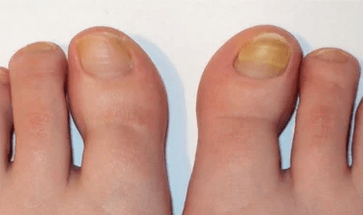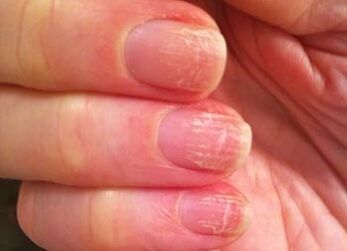
Mycoses, called fungal diseases in everyday life, have an infectious nature and are easily transmitted in contact with an infected person, animal or object.
Once on the skin or nails, the fungus immediately begins to eat tissues on which it appears, gradually governing more and more.With their enzymes, the fungus decomposes keratin, which is part of the tissues of the skin, hair and nails, that is, destroys them.
The mycosis of the nails at the initial stage differ only in less noticeable manifestation.But the disease is homogeneous throughout the course of the course and the basis of the treatment used.
How the nail fungus begins: Symptoms and photos
Initial nail mycosis cannot always be seen accidentally, as its manifestations can be insignificant.
The possible symptoms of this disease are the following:
- Changing the color of infected areas, often yellowing;
- The disappearance of the voice of the nails;
- The appearance of embossed spots, dots or strips on the nails;
- thickening, wool, instability or peeling of infected areas;
- Partial destruction of the nail at the edges and the skin above the nail;
- itching or pain in infection;
- Unpleasant nail odor.
The phenomena listed can be both symptoms of mycosis and a consequence of other factors, such as the following:
- lack of vitamins and minerals;
- accumulation of dead skin or dirt;
- Injuries;
- Taking some medicines;
- Non -infectious diseases: diabetes, psoriasis, eczema.
Thus, for accurate diagnosis of mycosis, even in the presence of symptoms, a laboratory analysis of the affected nail fragment is required.
Symptoms of initial nail fungus: Photo

The mycosis of the nails in the hands is a little more common than on the legs.
His manifestations are the same:
- stink;
- itching and pain;
- Nail and skin atrophy on it;
- change in the shape and color of the nails;
- Loss with the nails of the gloss and a change in their color.
The same symptoms may indicate the following factors:
- Malnutrition
- Long contact with cleaners or chemical reagents
- Taking certain medicines
- Some diseases of non -infectious nature.
Methods for the treatment of the nail fungus
It is necessary to treat fungal infections as it not only spoils the appearance of the hands or feet, but also leads to impaired immunity.As a result, people with fungus on the nails are more proposed to colds, flu and other infectious diseases.
Any way of treating nail mycosis should necessarily include measures to prevent recurrent infection.With the affected fabrics, the fungi fall on clothes, shoes and other objects that the patient touches with fingers or legs.
The following rules must therefore be observed:
- Infected shoes that have been used before the start of treatment, treat with special agents or discard them.
- Wear cotton socks before full recovery.
- Do not use slippers except those that are easy to wash (with a smooth inner surface).
- Replace socks and gloves to clean every day and use for washing at high temperature and iron.
- It is advisable to treat the shoes with ultraviolet antifungal lining throughout the treatment.
According to representatives of professional medicine, mycosis of the nails even in the initial stage requires systemic treatment in the first place, and the outer in the second.The choice of drugs is made depending on the type of existing fungi.Laboratory tests can determine it.
- Systemic anti -inflammal agents or antifungals.They accumulate in the nails and rocks of the horns of the skin.By penetrating the fungus into the cells, the active components of the drugs destroy their membrane or stop the synthesis of the substances that they eat.As a result, the fungus dies.Treatment should continue at least 3 months according to the following regimen: week of administration, three -week rest;So repeat 2 times.Then for another six months the drug will be present in the tissues affected by the sponge.Thus, a healthy nail will have time for growth and the fungus will not apply to it.Other treatments are used in addition to systemic therapy.The use of only local exposure methods can cure the infection for some time, but in this case there is a risk of relapse.
- Antifungal medicines with local use.These drugs soften the consistency of the nails affected by a plate.This effect allows you to easily remove the nails affected by the fungus, accelerates the growth of the new nail and increases the efficiency of systemic medicines.Antifungal agents are produced in the form of varnishes or ointments.The affected nails are covered with varnish and a simple cosmetic varnish is applied on top.
- Medical pedicure.This method is the removal of tissue tissue affected by the fungus and soft grinding of the toenails and legs with a special tool with many nozzles.The procedure lasts from 15 minutes to 2 hours and is performed 1 - 2 times a month.The duration of treatment is from 3 months to a year.The medical pedicure is performed in specialized offices.Not only does it cure the infection, it also improves the appearance of nails.After the first procedure, they look much better.And the signs of recovery become noticeable during the first 3 weeks of treatment.
- Ozone therapySThe introduction of ozone into the soft tissues near the nails reduces inflammation in them and increases local immunity.The course of treatment is at least 10 procedures, which take up to 20 minutes each.They are held 1 - 2 times a week.
- Traditional medicineIt offers the following method of treating nail fungus.The next sequence of actions should be carried out daily for at least 3 months or until a full recovery.In the evening, before you go to bed, stew your legs or hands (depending on the location of the infection) in a solution of soda for drinking at a temperature of 50 degrees.Apply cotton wool on each nail on the affected limb, well saturated with hydrogen peroxide or apple cider vinegar.Close your legs (brush) with a plastic wave with cellophane or glue them with a patch and go to bed.Throughout the treatment period, grease your nails as usual.
Prevention
Sources of mushroom infection are:
- public places where they go without shoes: baths, saunas, showers, gyms, beaches;
- Public items: shoes (most often slippers), gloves (such as boxing);
- carpets, most often in baths;
- Animals, including home and wool that have fallen from them;
- soil.
In order to minimize the likelihood of infection, it is necessary to observe the rules of hygiene:
- If possible, avoid contacts with sources of infection, especially wearing ordinary shoes and clothes
- Don't wear tight shoes
- Apply ultraviolet antifungal shoe finishes in coexistence with a person suffering from mycosis.
You should be aware that the fungi are able to live up after a few months of stay in the dried state.
The risk factors that are not amazed are the heredity and slow growth of the nails.The fungus is easier to spread through a slow -growing nail.Its growth rate decreases with age.
The immunity in this disease does not play a significant role, as it is much smaller in the nail area than in most bodily systems.
Professional medicine successfully treats Mycoses, both at the initial stage and after.However, it is not possible to get rid of this disease without consulting a specialist.


























